|
Note: I have recently been sent a lot of email from potential puppy buyers, saying that a breeder
is calling some of her puppies "White Chocolate". BUYER BEWARE. There is no such color. These puppies are
creams with incorrect pigment and incorrect eye color. This is usually a result of browns that have a heavy background
of cream. This is why it is so important to never breed browns to cream, red or apricot.
Please, before buying a poodle, do your research. You should never be charged more money for an exotic
color or a color that is a fault.
COMPARING BROWN TO CAFE AU LAIT
On this page I will be talking about the colors brown and cafe au lait in depth. You
would think that brown would be a straight forward color, however it seems to be confusing to many people.
I am also noticing that more and more breeders seem to be confused on the color of cafe au
lait. Many breeders think that their creams or light apricots are cafe. This just isnt correct. Cafe
au lait is just a shade of brown with more fading gene in it. I hope to help show the true cafe au lait color on
this page. I have collected color articles on poodles and will post them here along with pictures so help show
the difference. The authors of these articles are posted above and below the article. These articles are
older but are very good for defining color and giving you a good idea of how to get that color.
REMEMBER: Browns and bown shades such as Cafe Au Lait and Silver Beige must ALWAYS
have liver colored points and dark amber eyes. A brown with black points is a DISQUALIFYING FAULT!
Cafe Au Laits are most times born a dark brown then "clear" to the cafe color over time as
the coat matures. You can in rare cases have a Cafe born Cafe. However this dog will still be a definate light brown
color even though it is lighter in shade than brown.
*POINTS refers to the color of the nose, lips, eyeliner, and pads on a poodle.
BROWN COLOR ARTICLES
BROWN By Mrs Hoyt
–The New Book of the Poodle
Brown As previously mentioned, there
are two kinds of brown Poodles: a deep, rich mahogany or dark walnut in its perfect state, but usually seen in a lighter tone,
and a brilliant shade of chestnut, redder in tone than mahogany or walnut, but just as strong in tone and even right down
to the roots of the hair. In both browns, the eyes, eye rims, etc., are the same-the eyes brown, dark amber, sometimes a golden
brown, sometimes a reddish brown; eyerims, lips, nose, and toenails all brown to match the tone of the coat. Sometimes the
toenails are black, but never the lips, nose, and eyerims. The skin should match the tone of the coat in a lighter shade.
Common Faults: Dogs of the first brown may have some silvery hairs throughout the coat. Provided these are
not so numerous as to cause streaks or spots, this is not a serious fault.
Such dogs may have a small white or silver
patch on the chest or belly. If noticeable this is a show fault, and the breeder may wonder how much mixed color is behind
the dog. If very little, the breeder need not worry.
Such dogs, particularly the first mentioned brown, frequently
fade in color, leaving the ears, and often a dark streak down the back, the original color. This is a show fault but should
not affect the breeder .
Such dogs, due to hair loss through disease or injury, may grow hair back in the original
dark shade causing (especially if the coat has faded with age) an appearance of a dark spot or patch. This is a show fault
but need not effect the breeder. These "spots" in time usually fade to the resent coat color.
Such dogs often have
a pack lighter in tone than the main coat or the "ruff." Provided there is not a profound difference in tone, this is not
a serious fault.
Such dogs may have light yellow or almost green eyes. This is a major fault in the ring and is frequently
hard to eliminate in breeding.
Question: Does black combined with brown improve the color of the brown?
Answer:
No. The brown color is not affected by the introduction of black. The superbly colored French browns have often been brown-bred
for many generations. However, breeding to black does not harm brown, but there may be no brown puppies in the first generation
of the cross. Also there have been many excellent browns from two black parents.
Question: Does brown crossed
with brown tend to produce cafe-au-lait?
Answer: No, not unless both brown parents carry the cafe-au-lait gene
transmitted to them from a cafe-au-lait ancestor .
Question: Does brown bred to brown produce brown puppies?
Answer: If dogs of the same color brown are bred to one another, the answer is yes. However, there have been
many instances where brown bred to brown has produced black, gray, or blue. The following explanation is only theoretical
and has not been proved. Brown can carry black, gray, and blue. This coloring is blocked by two recessive genes. The brown
blocking genes in the two brown colors are different, and since it takes two like recessive genes to produce a visible effect,
the black, gray and blue are not block- ed when the colors we shall refer to as brown 1 and brown 2 are bred together. Therefore
black, gray, or blue puppies will result. This happens only when one or both parents carry black, gray, or blue. If they do
not, the puppies will be brown because the action of the blocking genes is not needed. If the parents are hybrid for the black,
BROWN By Mrs Hoyt
–The New Book of the Poodle
gray,
and blue genes, part of the litter will be brown and part the other colors. The reason that we cannot be more definite about
this and some of the other color theories is that we do not know exactly how the Poodle color genes are paired or how many
there are for each color. We think that brown is caused by a recessive color gene and a blocking gene when necessary, but
there may be more.
Question: Are browns more nervous and high- strung than blacks or whites?
Answer:
They often seem to be, and this may come from too much in-breeding to preserve this recessive color. The grays started
out with better temperaments than the blacks, but now in the Miniature, due to in-breeding, they have often become high-strung
and nervous. The Standard grays are beginning to be in-bred and some nervous temperaments are appearing. They started with
extra good temperaments. The gray Toys have as yet not been much
in-bred.
Question: Are the browns
popular in the show ring and with the public?
Answer: They do as well in the show ring as the blacks and almost
as well as the whites. They do much better than the grays and creams. A good brown is very dramatic, either indoors or out.
They are not as popular with the buying public. Brown puppies are definitely harder to sell, which may be because many browns
have light eyes, usually the ones for sale, and this gives them a hard, unappealing expression.
Question: What
are the best brown lines in Standards, Miniatures, and Toys for color?
Answer: The French and German lines
in all three varieties. There are good browns in England and America: too, but these come from basically black lines. There
are two exceptions to this, but they are very old lines. The Rufus line in combination with the base of the Leila line produced
deep red browns. The Loubet line was the brown 1 color.
BROWN By Mrs Hoyt –The
New Book of the Poodle
___________________________________________________________
BROWN From “The New Complete Poodle
by Lydia Hopkins – 1964”
Brown is a recessive
or dilution of black and closely related to it, although the color globules are different in shape. And if black is unharmed
by a brown cross, brown is greatly benefited by a black cross to keep the color and pigmentation dark.
Like all recessives,
brown bred to brown breeds true. For instance, my Ch. Sherwood The Chocolate Dandy, the only brown to appear in many generations
in a black-bred strain, when mated to a brown bitch invariably threw an entire litter of browns. Whereas, bred to a black
carrying a brown gene, the browns, if any, were in the minority. Of course, to produce even one brown puppy, both black parents
must carry a brown gene.
On the Continent
only the darkest shades of brown are recognized, such as the deepest shades of chocolate. But in England and with us, all
the various shades are allowed, and there is no color that has as many charming color variations. These range from almost
black chocolate-and by the way, all brown puppies, no matter what shade they are going to be in later life, are born very
dark. The beautiful reddish chestnut brown is brilliant, and there is a shade which is almost liver colored. I had a bitch
that was a dark walnut color like old furniture, and there are cinnamon browns both light and dark. There may be pale brown
of cafe-au-lait and parchment shades, and of course the various shades of gold from rich old gold to pale champagne. The pinkish
apricots and creams are all browns further diluted, with cream as the furthest dilution of all at the end of the line.
The worst and commonest
defect in browns is their marked tendency towards light eyes, pale yellow at their worst, with light pinkish eye-rims, lips,
and noses. This robs them of true Poodle outlook and expression and gives them either a bold or a vapid expression.
The eyes of all
browns, dark or light, should be several shades darker than their coats and just as dark as it is possible to get them. Dark
eyes are always surrounded by dark eye-rims, and the lips and nose are the same dark shade. One or two black crosses help
to keep the eyes and pigmentation dark. A really dark-eyed brown is invaluable for the breeding of browns.
In the lighter
dilute shades, it is possible to get actual black eyes and correct pigmentation, which adds a hundred percent to the attractiveness
of these charming colors.
BROWN From
“The New Complete Poodle by Lydia Hopkins – 1964”
____________________________________________________
BROWN - from an article by Pamela Ingram, Sassafrass Kennels
A brown poodle may vary in color from a very light chestnut color
to a brown so dark as to appear almost blk., called by
breeders, mahogany. If people like brown poodles they
REALLY like them and if they don't --- well they just
dont'.
A brown puppy is whelped brown all over and ALWAYS has a brown nose
and toenail, although they are sometimes so dark as to
appear blk. The puppy should be an even shade of brown
from it's head to it's tail and the all important place
for the breeder to inspect on newly whelped pups---in between the
pads of the feet. A brown remainig dark for a very long time will have no white hairs in the pads. If it is sprinkled with white hairs it will either be a lighter brown or it will get many white hairs in the coat early in life and become a cafe au lait shade.
At six wks of age the puppy when clipped should be appreciably lighter
on face, feet, and tail. If the face is the same color
as the main coat it will stay darker longer. However,
if the face is on the other hand , appreciably lighter
at six weeks, it will lighten quickly and be a lighter brown at maturity.
As the brown puppy grows the coat stays approximately the same color
without appreciable lightening, and will stay about the same color until
about 2 yrs. of age. Those browns that start having many white hairs sprinkled through the coat will end up cafe au lait in color. From three yrs of age on, the brown poodles (even more so than blks. ) do not hold their dark color for very many years. They do lighten very much like the blues. I have never seen a brown so dark as to appear almost blk. at the age of , for instance, seven yrs. They do alas fade---some lines earlier and more than others. Most of those glorious dark mahoganies are young dogs and this, I might add, is irrespective
of the variety---Standard, Miniature, or Toy. I have been told there are some great "holding browns" in Europe but have never actually seen them. As I have said so many times---different linesor
families do different things.
It has been my experience that browns seem to have an unusual change
in their color pattern. Their tails will start turning
many of degrees lighter than, for example, the feathers
on ears even close to the skin, and from their lightened
tails the lightening spreads, The blues also tend to fade in the
same manner.
Sun, chlorine, also sea water have a strong bleaching effect---so
brown dogs should be kept mostly inside.
Those reports of browns with blk. noses and very, very dark brown
coats will be found, in reality, to be off-blacks or
blue-blacks which during a stage in their lives ( and during a coat and color changing period ) will appear brown. This browning is due, again, to sun or chlorine factors and they will, become charcoal or grey dogs in their third to fourth year of life.
BREEDING BROWNS
Brown is a recessive color and should therefore breed true. A recessive
color is one which is hidden or covered by a stronger
or dominant color, such as black. Black being stronger
will cover brown, like a blob of blackin dropped on a
blob of brown ink. Thus, if a blk. poodle carrying no brown genes
is bred to a brown poodle, all puppies will be blk. If one or more puppies
are brown, with this blk. sire, he must be carrying a recessive brown gene.
Two blks. can also have brown puppies---but not unless both are carrying
these recessive of hidden brown genes. I have heard of
blk. coming from two brown parents, and submit that the
only logical thought is that they could, basically, be
greys whelped black, and turn grey or charcoal as grey and
silver are also recessive colors---but in my experience, brown bred to brown produces brown. However, since different lines and families of poodles seem to act differently, it is, I suppose, (accident eliminated) possible.
All I have ever seen is that in a litter of browns the darkest will
be, at maturity, as dark or nearly as dark as the darkest
parent and the lightest in the litter, as light or lighter
than, the lightest brown parent.
To obtain really dark browns they must either be bred from very dark
(almost) nonfading browns or from blacks which stay black.
Any fading or diluting factor will make browns fade out.
The best way to achieve this is, of course, to take always
the deepest black which holds it's color and the darkest
brown which does not fade in every litter and breed them generation after generation taking care when doing so to also take the darkest eye and the best pigment---this may be the best way to achieve the darkest color but it also could result in an otherwise less desirable dog.
Even with all the problems and pitfalls possible in the breeding of
these darkest browns, it is truly an exciting and sought
after color---sought after also by our buying public.
The public is most important, I am sure you will have
to agree. They too will wait a long time for a really
great colored brown for, as I have said, "those that
love this color TRULY love and appreciate it.
from an article by Pamela Ingram, Sassafrass Kennels
Picture examples of the brown color in poodles with proper pigment.
| NEWBORN BROWN TOY PUPS |
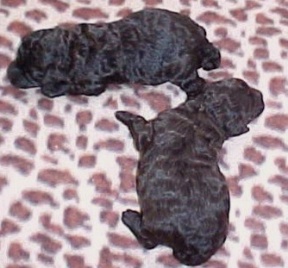
|
| BROWN PUPPY |
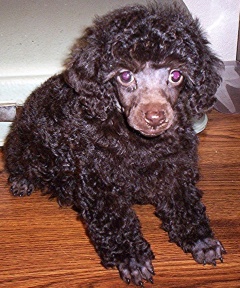
|
| BROWN STANDARD PUPPY |
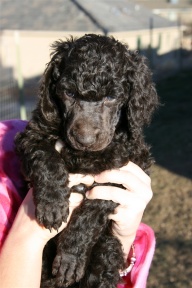
|
| BROWN STANDARD PUPPY |
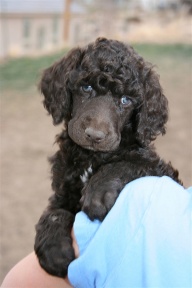
|
| BROWN ADULT TOY |
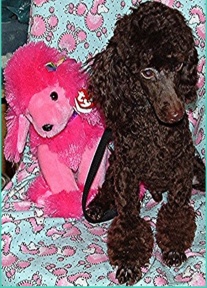
|
|